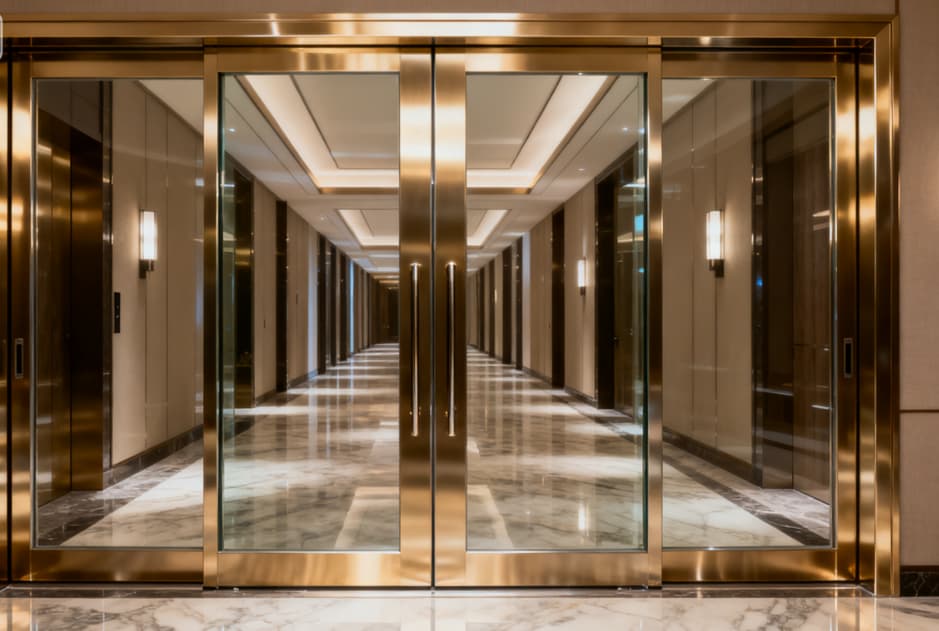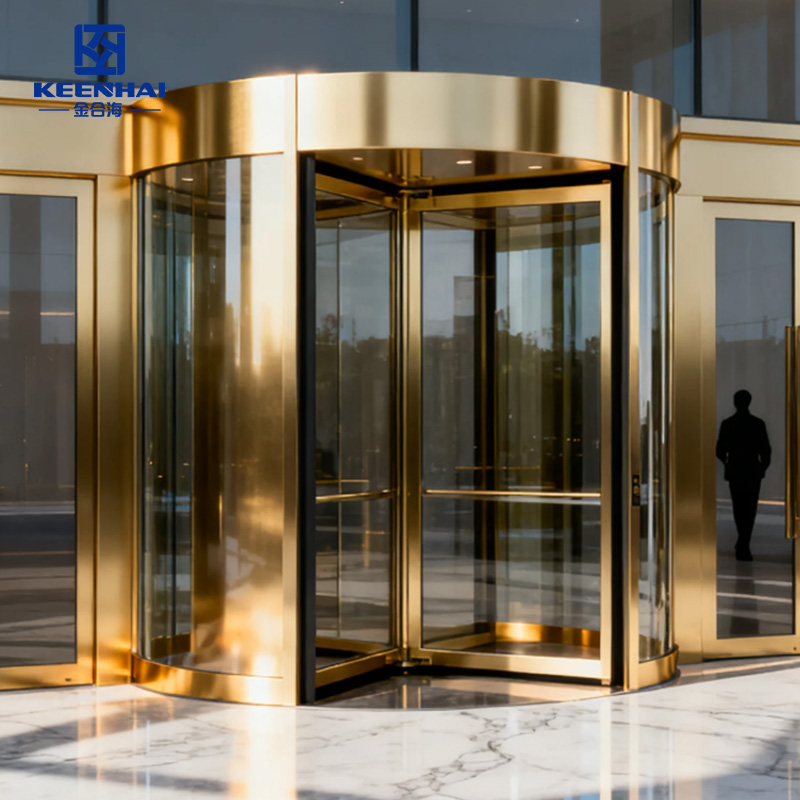Stainless steel sliding doors offer superior durability, corrosion resistance, and ease of use. Unlike hinged doors, they require no swing space, which maximizes interior floor area and improves traffic flow. Their automated or manual operation is smooth, quiet, and reliable even under high daily usage, making them ideal for hotels, offices, and commercial spaces.
1. Material Strength and Structural Integrity
1.1 Load-Bearing Capacity of Stainless Steel Sliding Doors
Premium stainless steel sliding doors are engineered to handle substantial weight without compromising smooth operation. High-grade 304 or 316 stainless steel provides superior tensile strength, allowing panels to span wide openings up to 5 meters without additional support. In commercial buildings, these doors can bear heavy glass or composite inserts while maintaining alignment, thanks to reinforced track systems and precision-engineered rollers.
For automated installations, Automatic Stainless Steel Sliding Doors integrate counterbalanced mechanisms and high-strength frames, distributing load evenly and reducing stress on the moving parts. This design ensures that even with frequent use—hundreds of cycles per day—the door maintains its structural integrity and smooth motion for decades.
1.2 Frame Stability and Hinge Stress in Traditional Hinged Doors
Traditional hinged doors rely heavily on their pivot points and supporting frames. Over time, repetitive opening and closing can create stress concentrations at the hinges, leading to sagging, misalignment, and uneven gaps. This is particularly noticeable in large or heavy doors made from solid wood or aluminum alloys.
| Door Type | Max Width (m) | Max Weight (kg) | Common Issues Over Time | Maintenance Needs |
|---|---|---|---|---|
| Skyvedør i rustfritt stål | 5 | 300 | Minimal sagging, stable alignment | Track lubrication, periodic roller check |
| Traditional Hinged Door | 1.2–2 | 100–150 | Hinge sag, frame warping | Hinge tightening, frame adjustment, repainting |
The table above illustrates why sliding systems inherently distribute forces more efficiently, reducing structural strain compared to hinged mechanisms. In high-traffic areas, hinged doors require frequent frame inspections and hinge adjustments, whereas premium sliding doors remain stable with minimal intervention.
1.3 Resistance to Dents, Warping, and Deformation
One of the key advantages of stainless steel sliding doors is their resistance to physical damage. The dense alloy structure and corrosion-resistant properties make the panels highly resistant to dents and warping, even under daily impacts from luggage, carts, or frequent pedestrian traffic. Hotels and airports often prefer Hotel Automatic Stainless Steel Sliding Doors for precisely this reason—they maintain appearance and function under constant use.
In contrast, traditional hinged doors, especially those made from aluminum or softwood, deform more easily under stress. Warping can cause doors to stick or misalign, and dents are more visible on flat panels. For large installations where appearance and consistent operation are critical, sliding systems clearly outperform hinged designs.

2. Space Efficiency and Functional Design
2.1 Footprint and Clearance Requirements
Premium stainless doors occupy significantly less floor space compared to traditional hinged doors. Hinged doors require a clear swing radius equal to the door width plus clearance, often consuming 1–2 square meters per door in residential settings and even more in commercial spaces. Sliding doors, however, move parallel to the wall, allowing full utilization of interior space. In hotels or office lobbies, this can translate into 20–30% more usable floor area, which is especially valuable in high-density environments.
For large installations, the track system can be recessed into the ceiling or floor, creating a flush, unobstructed opening. Proper installation involves:
-
Measuring the wall or partition length accurately.
-
Installing the top track and reinforcing supports.
-
Ensuring the door panel slides freely without friction or misalignment.
This layout minimizes operational space requirements while maintaining smooth performance.
2.2 Ease of Access and Flow in High-Traffic Areas
High-traffic areas like airports, shopping centers, and hospitals benefit from sliding doors because they allow continuous, unimpeded flow of people and equipment. Unlike hinged doors, which can bottleneck during peak hours, sliding doors maintain a steady stream. For automated systems, motion sensors trigger smooth operation, reducing collision risk and improving accessibility for wheelchairs, carts, and luggage.
Hotels often choose Automatic Stainless Steel Sliding Doors in main entrances for these reasons. The automated function distributes opening and closing forces evenly, avoiding jams, while the wide panel design accommodates simultaneous bidirectional traffic. Frequent daily operation—over 500 cycles—is sustainable with minimal maintenance, making it ideal for commercial projects.
2.3 Adaptability to Large Openings
Sliding systems are inherently more adaptable for large-scale entrances. Panels can be combined or customized to span widths exceeding 5 meters, something that would require double or triple hinged doors with complex structural reinforcement. Stainless Steel Sliding Door systems maintain alignment across wide spans thanks to precision rollers and reinforced tracks.
The process for accommodating large openings includes:
-
Selecting appropriate panel thickness and alloy grade (typically 304 or 316 stainless steel).
-
Reinforcing top tracks and floor guides to prevent sagging.
-
Installing adjustable rollers to distribute weight evenly and ensure smooth glide.
This flexibility allows architects to design grand entrances without compromising safety, aesthetics, or operational reliability.

3. Durability and Maintenance Requirements
3.1 Surface Wear, Corrosion, and Rust Resistance
Premium stainless steel sliding doors are engineered to withstand harsh conditions while maintaining their finish and structural integrity. High-grade 304 or 316 stainless steel resists rust, corrosion, and surface pitting, making these doors suitable for coastal environments or areas with high humidity. In contrast, aluminum sliding doors, while lightweight, can oxidize and develop surface blemishes over time if exposed to salt air or frequent cleaning chemicals.
| Trekk | Skyvedør i rustfritt stål | Aluminum Sliding Door |
|---|---|---|
| Korrosjonsbestandighet | Excellent (316 alloy: marine-grade) | Moderate, prone to oxidation |
| Surface Hardness | 150–200 HV (high scratch resistance) | 70–120 HV (softer, more dents) |
| Maintenance Frequency | Low, annual inspection | Medium, quarterly cleaning & protective coating |
| Typical Usage | Commercial, high-traffic | Residential, low-to-medium traffic |
This table highlights why stainless steel systems remain structurally and visually stable over years, especially in commercial installations.
3.2 Cleaning and Lubrication Needs
To maintain smooth operation and appearance, regular care is essential:
-
Surface cleaning: Use mild detergent and soft cloth; avoid abrasive pads that can scratch protective finishes.
-
Track maintenance: Remove debris, dust, or small stones that could obstruct rollers.
-
Lubrication: Apply silicone-based or Teflon lubricant to rollers and track guides every 6–12 months.
Automated variants like Automatic Stainless Steel Sliding Doors require additional sensor and motor checks to ensure consistent response and prevent premature wear. Following these steps extends the door’s lifespan while keeping it operating quietly and efficiently.
3.3 Typical Lifespan and Replacement Frequency
Premium stainless steel sliding doors generally last 20–30 år in commercial settings with routine maintenance, while aluminum sliding doors often require replacement after 10–15 years, depending on environmental exposure and traffic levels. In hotels or hospitals, where doors operate hundreds of cycles daily, stainless steel systems maintain alignment, resist deformation, and reduce downtime.
Regular inspection of rollers, tracks, and seals ensures consistent performance. By addressing minor wear early, facilities can maximize ROI and avoid costly emergency replacements. Properly maintained systems also maintain aesthetic appeal over decades, a key consideration for premium entrances in high-visibility areas.
4. Operational Performance and Convenience
4.1 Smoothness of Motion and Noise Levels
High-quality sliding systems deliver consistently smooth motion with minimal operational noise, even under heavy usage. Precision-engineered rollers, reinforced tracks, and anti-vibration components reduce friction and prevent rattling, making the doors almost silent in operation. In commercial buildings or hotel lobbies, noise reduction enhances guest experience, especially in quiet zones such as conference areas or medical facilities.
Regular maintenance to preserve performance includes:
-
Cleaning the track to remove dust and debris.
-
Lubricating rollers with a silicone-based lubricant every 6–12 months.
-
Checking alignment periodically to prevent uneven stress and wear.
These steps ensure the door slides effortlessly, even with panels weighing several hundred kilograms.
4.2 Automation Compatibility and Smart Controls
Moderne Automatic Stainless Steel Sliding Doors integrate seamlessly with building automation systems. Motion sensors, access control, and remote monitoring enable adaptive operation based on traffic flow. Typical settings include:
-
Sensor sensitivity adjustment to avoid false triggers.
-
Speed calibration for smooth acceleration and deceleration.
-
Emergency stop and safety override for compliance with accessibility regulations.
These features ensure doors operate efficiently without manual intervention, reducing labor requirements and enhancing user convenience in high-traffic environments.
4.3 Ease of Operation for Children, Elderly, and Disabled Users
Sliding doors provide superior accessibility compared to traditional hinged doors, as they require minimal physical effort to operate. Motion-sensor or automated doors eliminate the need for pushing or pulling, which can be challenging for children, elderly users, or those with mobility aids.
Key considerations include:
-
Ensuring sensor height and detection zone covers all user profiles.
-
Adjusting door speed to allow safe passage for slower movers.
-
Maintaining clear, unobstructed tracks to prevent tripping hazards.
These operational advantages make sliding doors ideal for public spaces such as hospitals, airports, and schools, providing a combination of safety, convenience, and reliable performance.

5. Energy Efficiency and Environmental Impact
5.1 Insulation and Heat Transfer Comparison
Sliding doors made from high-grade rustfritt stål provide superior thermal performance compared to standard aluminum or traditional hinged doors. The dense steel alloy combined with double-glazed panels minimizes heat transfer, keeping interiors cooler in summer and warmer in winter. Thermal conductivity for stainless steel is roughly 16 W/m·K, significantly lower than uncoated aluminum at 205 W/m·K, which means stainless systems reduce energy loss and improve overall insulation.
| Trekk | Skyvedører i rustfritt stål | Aluminum Hinged Doors |
|---|---|---|
| Thermal Conductivity | 16 W/m·K | 205 W/m·K |
| Double-Glazed Panel Compatibility | Excellent | Moderate |
| Seasonal Energy Savings | Up to 15–20% | 5–8% |
| Indoor Comfort Stability | High | Medium |
This comparison demonstrates how premium stainless systems contribute to energy efficiency, especially in climates with extreme temperatures.
5.2 Weatherproofing and Seal Integrity
Effective weatherproofing is critical to maintain energy performance. High-quality sliding doors use multi-layered seals and gasket systems that prevent drafts, water ingress, and dust penetration. Properly installed doors ensure consistent seal pressure along the entire frame, avoiding weak points where thermal loss or moisture intrusion can occur.
Key installation steps for optimal seal performance:
-
Check the frame is level and square before sealing.
-
Apply weatherstripping along the bottom and sides of the door.
-
Test the sliding motion to ensure the seals compress evenly without creating drag.
These measures protect interior spaces while enhancing operational smoothness over years of daily use.
5.3 Impact on HVAC Costs
Efficient insulation directly reduces heating and cooling demand. Buildings with stainless steel sliding doors experience lower HVAC loads because the doors maintain stable indoor temperatures, especially in high-traffic areas where doors open frequently. Studies indicate premium sliding systems can cut HVAC energy consumption by 10–15% annually compared to conventional aluminum hinged doors, translating to measurable cost savings over the door’s lifespan.
Beyond energy efficiency, using stainless steel sliding doors also lowers maintenance-related environmental impact, as long-lasting materials reduce the need for frequent replacements and associated manufacturing emissions.






